
Ziyi Wu1,2,
Jingyu Hu1,*,
Wuyue Lu1,*,
Igor Gilitschenski1,2,
Animesh Garg1,2
1University of Toronto
2Vector Institute
* Equal contribution
Object-centric learning aims to represent visual data with a set of object entities (a.k.a. slots), providing structured representations that enable systematic generalization. Leveraging advanced architectures like Transformers, recent approaches have made significant progress in unsupervised object discovery. In addition, slot-based representations hold great potential for generative modeling, such as controllable image generation and object manipulation in image editing. However, current slot-based methods often produce blurry images and distorted objects, exhibiting poor generative modeling capabilities. In this paper, we focus on improving slot-to-image decoding, a crucial aspect for high-quality visual generation. We introduce SlotDiffusion -- an object-centric Latent Diffusion Model (LDM) designed for both image and video data. Thanks to the powerful modeling capacity of LDMs, SlotDiffusion surpasses previous slot models in unsupervised object segmentation and visual generation across six datasets. Furthermore, our learned object features can be utilized by existing object-centric dynamics models, improving video prediction quality and downstream temporal reasoning tasks. Finally, we demonstrate the scalability of SlotDiffusion to unconstrained real-world datasets such as PASCAL VOC and COCO, when integrated with self-supervised pre-trained image encoders.

Overview of a general object-centric learning framework on videos (a). The model performs Slot Attention to capture objects with slots, and decodes slots back to images for the reconstruction loss. Previous methods have explored two types of slot decoders: mixture-based (b) and Transformer-based (c).
However, models with mixture-based decoders [1, 2] cannot segment objects from complex videos, while models with Transformer-based decoders [3, 4] generate distorted images from slots, and thus are not suitable for object-centric generative models (e.g. video prediction [7]).
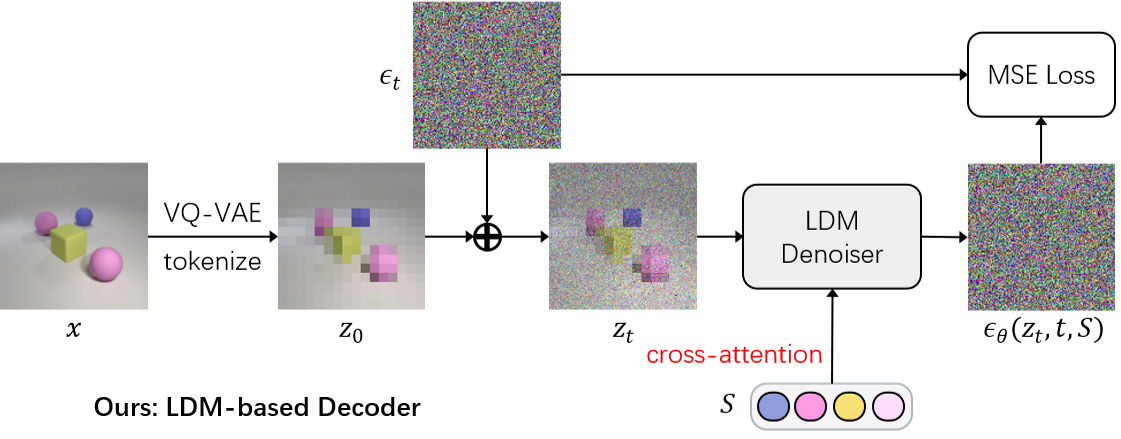
In this paper, we instead propose a Latent Diffusion Model (LDM) [6] based slot decoder. Given an image $x$, we first leverage a pre-trained VQ-VAE encoder to tokenize it as $z$, and add random Gaussian noise on it as $z_t$. Then, a U-Net is trained to predict the noise $\epsilon_t$ conditioned on slots $\mathcal{S}$. The slot conditioning is achieved via cross-attention.
Thanks to the strong modeling capacity of diffusion models, our method, SlotDiffusion, achieves state-of-the-art results in both unsupervised object segmentation and generative modeling.
We mainly compare with four baselines: SA (mixture) and SLATE (Transformer) on images, SAVi (mixture) and STEVE (Transformer) on videos. We keep all model components the same, and only replace our slot decoder with an LDM.
We show unsupervised scene decomposition results on MOVi videos. SAVi degenerates to trivial stripe patterns. Compared to STEVE, SlotDiffusion achieve better slot tracking and less object-sharing issue, especially on large objects.
| Video | GT | SAVi | STEVE | Ours |
|---|




Object-centric generative models enjoy several advantages, e.g. explicit modeling of object interactions, interpretable image editing. Their generation process often consist of two steps: i) predicting slots in the latent space; ii) decoding slots back to the pixel space. Therefore, their generation quality is bounded by the slot-to-image decoding quality.
We first show some image (CLEVRTex & CelebA) and video (MOVi) reconstruction results. SlotDiffusion preserves local details much better, such as the textures on objects and backgrounds, and the human hairs and facial features.
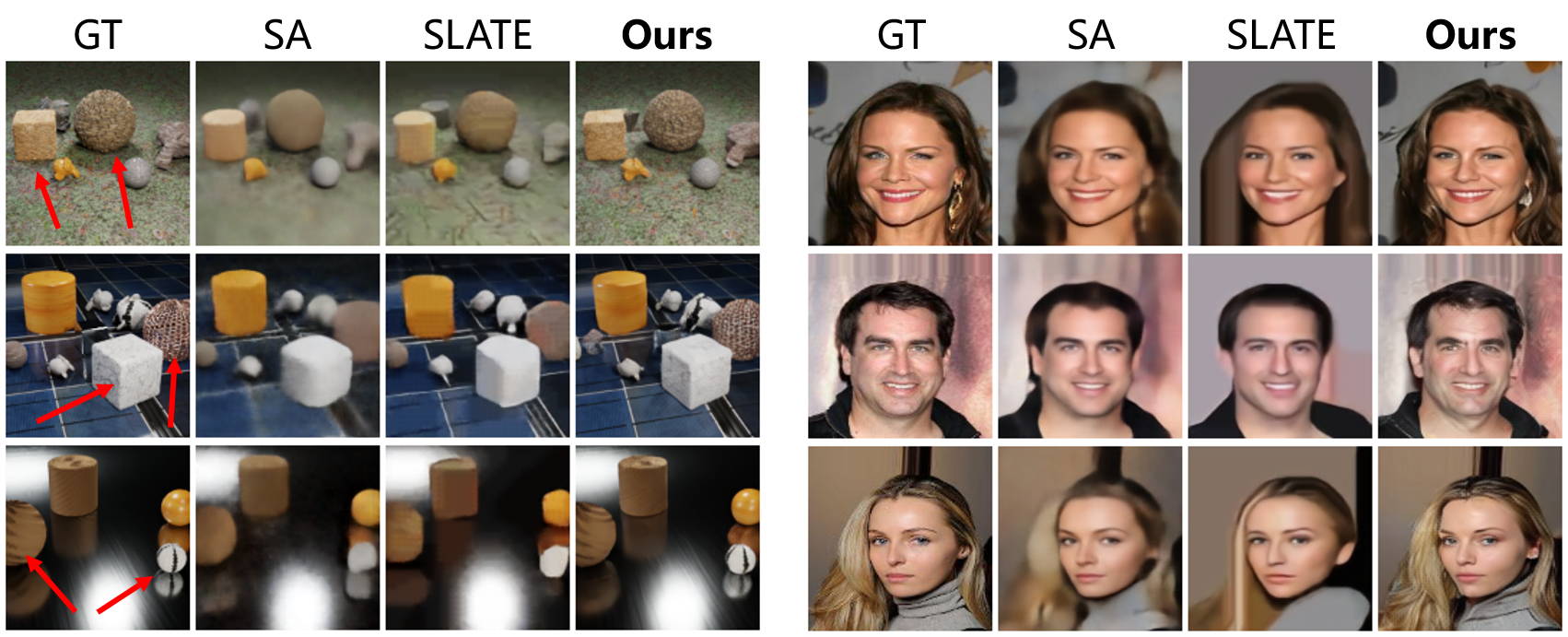
| GT | SAVi | STEVE | Ours |
|---|




We then show results on compositional generation. We treat object slots as basic visual concepts, similar to phrases in a sentence. As shown below, SlotDiffusion discovers objects with different shapes on CLEVRTex, and decompose CelebA images to clothes, hairs, faces and backgrounds.

After building a visual concept library (see paper Section 3.3), we are able to generate novel samples by randomly composing different concept slots.

We show more results below. Compared to baselines, SlotDiffusion generates results closer to the original datasets.
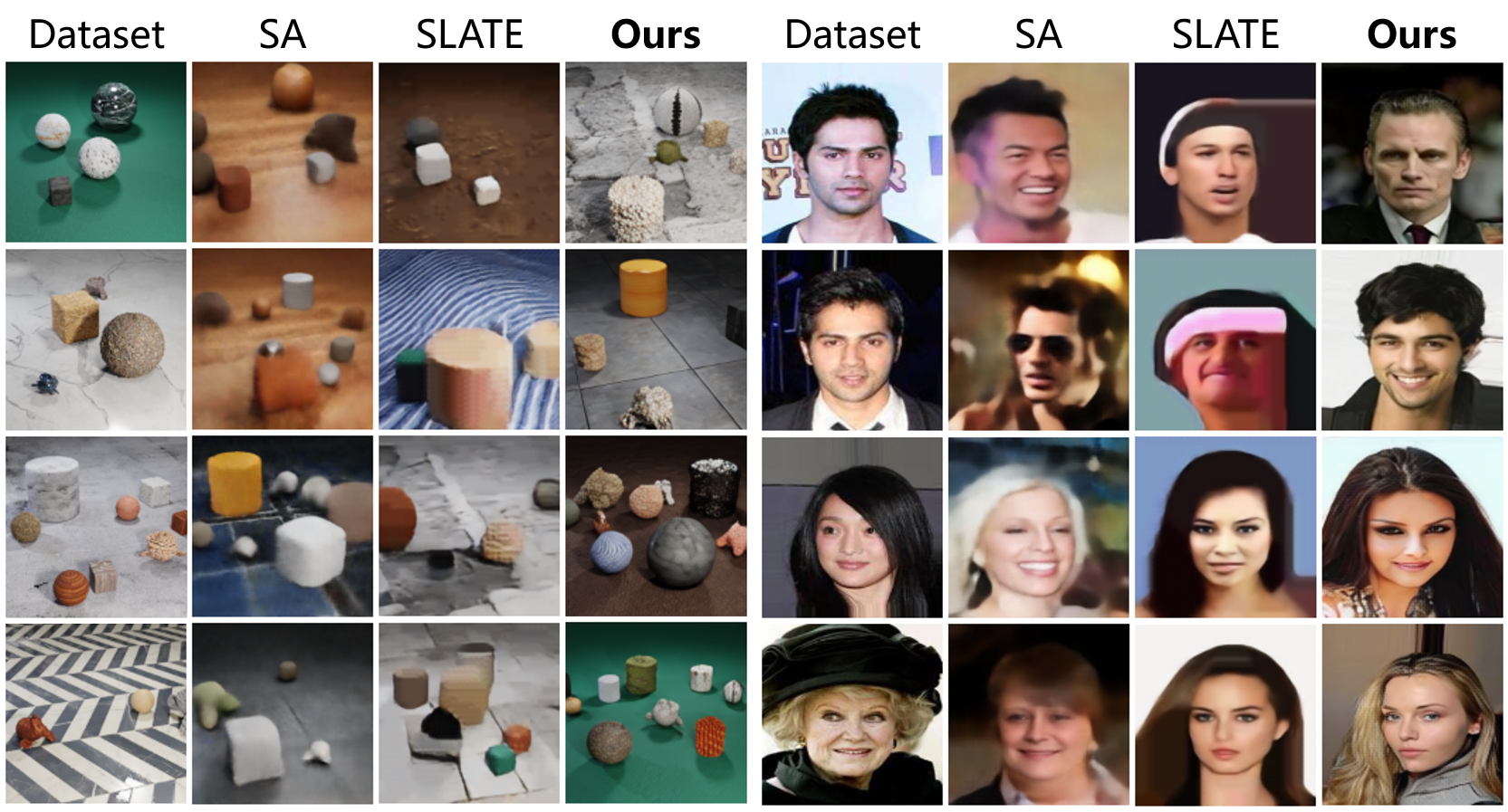
Finally, we show that SlotDiffusion can edit images by manipulating object slots. For example, we can replace the human faces by swapping the corresponding slots, while keeping the clothes, hairs and backgrounds unchanged.
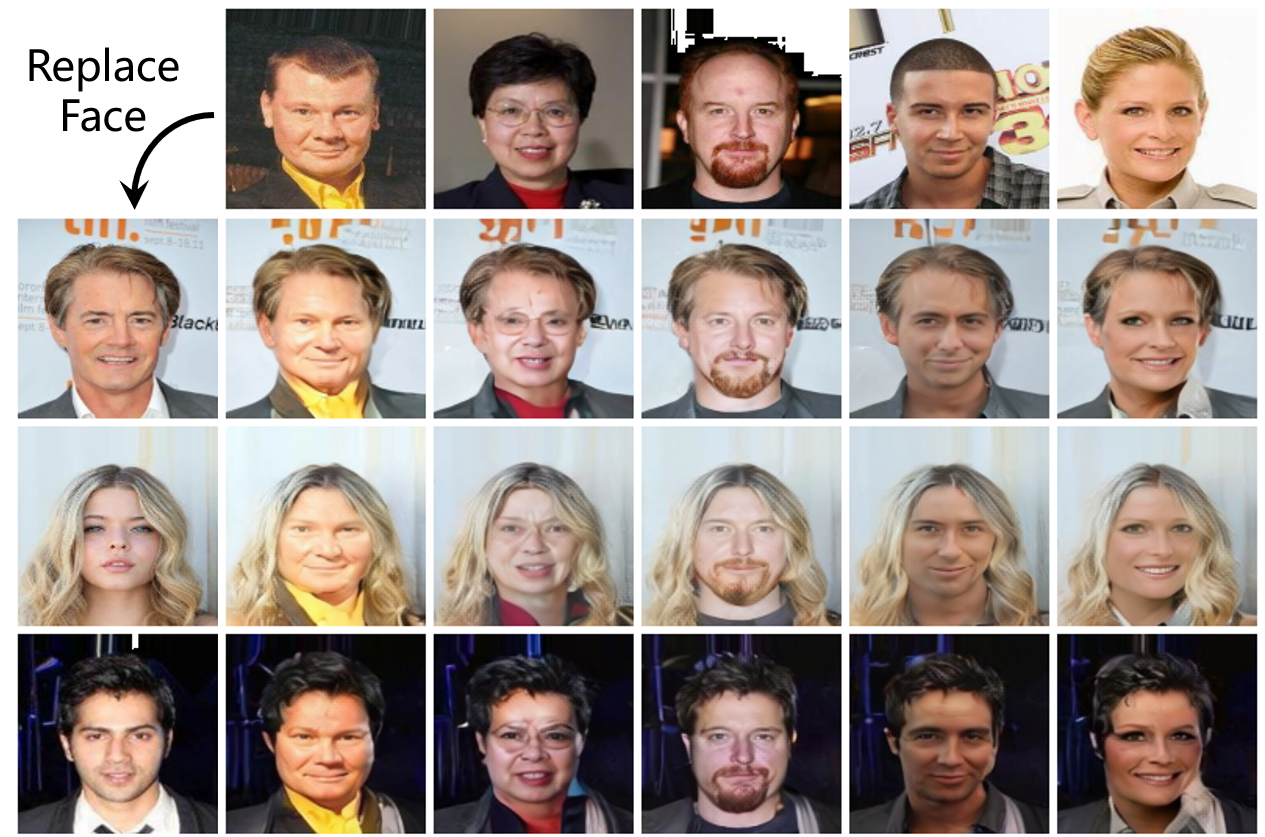
We can also remove/segment objects from a scene, insert a new object from another scene, get its background image and swap it with a novel background image from another scene.
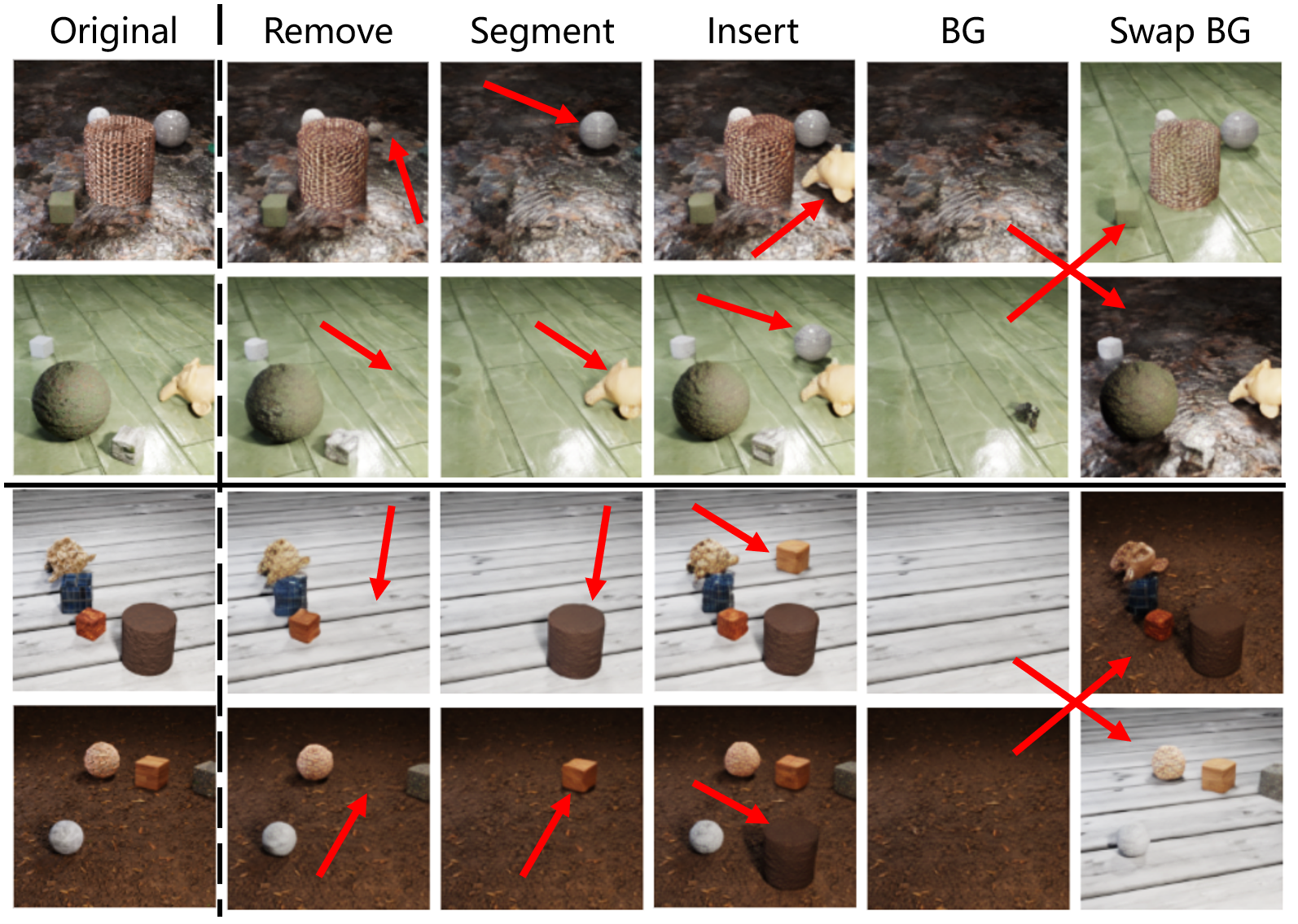
We now show how SlotDiffusion's better slot decoder can help downstream video prediction and VQA tasks on Physion dataset. We train an object-centric dynamics model SlotFormer (SF for short) [7] over learned slots, and perform future rollout. Then, we reason the predicted future to answer questions. Our method simulates both correct object dynamics and better visual quality. We also achieve SOTA VQA results on Physion (see paper Section 4.4).
| Video | PredRNN | VQFormer | STEVE + SF | Ours + SF |
|---|
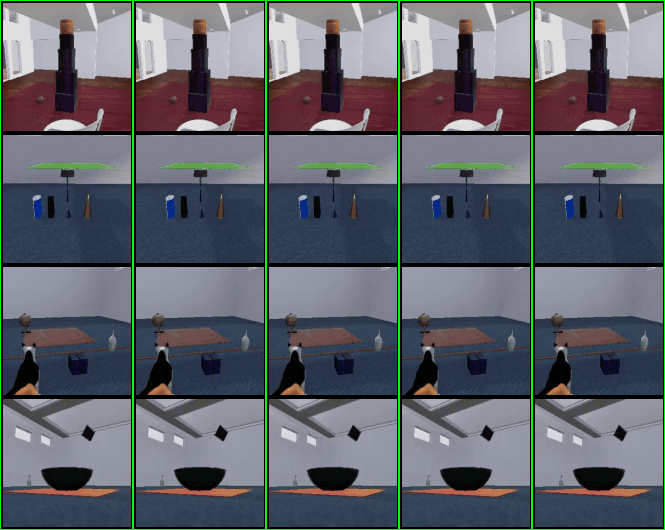
Finally, we show that SlotDiffusion can scale up to real-world datasets MS COCO and PASCAL VOC with the help of DINO [14] pre-trained image encoders. Our method not only segments major objects, but also discovers unannotated yet semantically meaningful regions, such as trees and keyboards.

[1] Locatello, Francesco, et al. "Object-Centric Learning with
Slot Attention." NeurIPS. 2020.
[2] Kipf, Thomas, et al. "Conditional Object-Centric Learning
from Video." ICLR. 2021.
[3] Singh, Gautam, et al. "Illiterate DALL-E Learns to Compose."
ICLR. 2022.
[4] Singh, Gautam, et al. "Simple Unsupervised Object-Centric
Learning for Complex and Naturalistic Videos." NeurIPS. 2022.
[5] Ho, Jonathan, et al. "Denoising Diffusion Probabilistic
Models." ICML. 2020.
[6] Rombach, Robin, et al. "High-Resolution Image Synthesis with
Latent Diffusion Models." CVPR. 2022.
[7] Wu, Ziyi, et al. "SlotFormer: Unsupervised Visual Dynamics
Simulation with Object-Centric Models." ICLR. 2023.
[8] Bear, Daniel, et al. "Physion: Evaluating Physical
Prediction from Vision in Humans and Machines." NeurIPS Datasets
and Benchmarks Track. 2021.
[9] Wang, Yunbo, et al. "PredRNN: Recurrent Neural Networks for
Predictive Learning using Spatiotemporal LSTMs." NeurIPS. 2017.
[10] Karazija, Laurynas, et al. "CLEVRTex: A Texture-Rich
Benchmark for Unsupervised Multi-Object Segmentation." NeurIPS
Datasets and Benchmarks Track. 2021.
[11] Liu, Ziwei, et al. "Large-Scale Celeb Faces Attributes
(CelebA) Dataset." 2018.
[12] Everingham, Mark, et al. "The Pascal Visual Object Classes
(VOC) Challenge." IJCV. 2010.
[13] Lin, Tsung-Yi, et al. "Microsoft COCO: Common Objects in
Context." ECCV. 2014.
[14] Caron, Mathilde, et al. "Emerging Properties in
Self-Supervised Vision Transformers." ICCV. 2021.
[15] Seitzer, Maximilian, et al. "Bridging the Gap to Real-World
Object-Centric Learning." ICLR. 2023.
[16] Greff, Klaus, et al. "Kubric: A Scalable Dataset
Generator." CVPR. 2022.